The Effect of Altitude on Phenolic, Antioxidant and Fatty Acid Compositions of Some Turkish Hazelnut (Coryllus avellana L.) Cultivars
Abstract
1. Introduction
2. Results
2.1. Content of Polyphenols
2.2. Total Phenol Content (TPC)
2.3. DPPH and ABTS•+ Free Radical Scavenging Activity
2.4. Fatty Acids (FAs) Fluctuation
2.5. Statistical Approaches
3. Discussion
4. Materials and Methods
4.1. Research Sites and Cultivar Choice
4.2. Fruit Sampling
4.3. Phenolic Content Analysis
4.4. Total Phenol Content (TPC) Assay
4.5. DPPH Free Radical-Scavenging Assay
- Asample: absorbance of the sample;
- Acontrol: absorbance of control.
4.6. ABTS Free Radical Scavenging Activity Assay
- Asample: absorbance of the sample;
- Acontrol: absorbance of control.
4.7. Fatty Acids Analysis
4.8. Statistical Analysis
5. Conclusions
Supplementary Materials
Author Contributions
Funding
Institutional Review Board Statement
Informed Consent Statement
Data Availability Statement
Conflicts of Interest
Sample Availability
References
- Plamada, D.; Teleky, B.-E.; Nemes, S.A.; Mitrea, L.; Szabo, K.; Calinoiu, L.-F.; Pascuta, M.S.; Varvara, R.-A.; Ciont, C.; Mărtau, G.A.; et al. Plant-Based Dairy Alternatives—A Future Direction to the Milky Way. Foods 2023, 12, 1883. [Google Scholar] [CrossRef] [PubMed]
- Alalwan, T.A.; Mohammed, D.; Hasan, M.; Sergi, D.; Ferraris, C.; Gasparri, C.; Rondanelli, M.; Perna, S. Almond, Hazelnut, and Pistachio Skin: An Opportunity for Nutraceuticals. Nutraceuticals 2022, 2, 300–310. [Google Scholar] [CrossRef]
- Gunes, N.T.; Köksal, A.İ.; Artık, N.; Poyrazoglu, E. Biochemical Content of Hazelnut (Corylusavellana L.) Cultivars from West Black Sea Region of Turkey. Eur. J. Hortic. Sci. 2010, 75, 77–84. [Google Scholar]
- Dobhal, K.; Singh, N.; Semwal, A.; Negi, A. A brief review on: Hazelnuts. Int. J. Recent Sci. Res. 2018, 9, 23680–23684. [Google Scholar]
- Koksal, A.I.; Artik, N.; Şimşek, A.; Gunes, N. Nutrient composition of hazelnut (Corylusavellana L.) varietiescultivated in Turkey. Food Chem. 2006, 99, 509–515. [Google Scholar] [CrossRef]
- Oliveira, I.; Sousa, A.; Morais, J.; Ferreira, I.C.F.R.; Bento, A.; Estevinho, L.; Pereira, J.Á. Chemical composition, and antioxidant and antimicrobial activities of three hazelnut (Corylus avellana L.) cultivars. Food Chem. Toxicol. 2008, 46, 1801–1807. [Google Scholar] [CrossRef]
- Xu, Y.; Hanna, M.A. Nutritional and anti-nutritional compositions of defatted Nebraska hybrid hazelnut meal. Int. J. Food Sci. Technol. 2011, 46, 2022–2029. [Google Scholar] [CrossRef]
- Cosmulescu, S.; Mihai, B.O.T.U.; Trandafir, I. The mineral source for human nutrition of nuts in different hazelnut (Corylus avellana L.) cultivars. Not. Bot. Horti Agrobot. Cluj-Napoca 2013, 41, 250–254. [Google Scholar] [CrossRef]
- Özcan, M.M.; Uslu, N. Investigation of changes in total phenol, flavonoid, antioxidant activity, fatty acids, polyphenol and mineral profiles of hazelnut kernels dried in air, oven and microwave. JSFA Rep. 2023, 3, 72–81. [Google Scholar] [CrossRef]
- Yorulmaz, A.; Velioglu, Y.S.; Tekin, A.; Simsek, A.; Drover, J.C.; Ates, J. Phytosterols in 17 Turkish hazelnut (Corylus avellana L.) cultivars. Eur. J. Lipid Sci. Technol. 2009, 111, 402–408. [Google Scholar] [CrossRef]
- Piccinelli, A.L.; Pagano, I.; Esposito, T.; Mencherini, T.; Porta, A.; Petrone, A.M.; Gazzerro, P.; Picerno, P.; Sansone, F.; Rastrelli, L.; et al. HRMS Profile of a Hazelnut Skin Proanthocyanidinrich Fraction with Antioxidant and Anti-Candida albicans Activities. J. Agric. Food Chem. 2016, 64, 585–595. [Google Scholar] [CrossRef]
- Yazlık, A. Dominant weed species exert significant impacts on hazelnut orchards and rural livelihoods. Cogent. Food Agric. 2023, 9, 2172988. [Google Scholar] [CrossRef]
- Güler, E.; Balta, F. Determination of yield and quality characteristics of hazelnut populations of Taskesti district (Mudurnu-Bolu). Uluslar. Tarim Ve Yaban Hayati Bilim. Derg. 2020, 6, 115–128. [Google Scholar] [CrossRef]
- Tercan, E.; Dengiz, O.; Özkan, B.; Dereli, M.A.; Öztekin, Y.B. Geographic information system–assisted site quality assessment for hazelnut cultivation using multi-criteria decision analysis in the Black Sea region, Turkey. Environ. Sci. Pollut. Res. 2022, 29, 35908–35933. [Google Scholar] [CrossRef]
- FAO. 2023. Available online: https://fenix.fao.org/faostat/internal/en/#data/QCL/visualize (accessed on 25 March 2023).
- Bacchetta, L.; Aramini, M.; Procacci, S.; Zinni, A.; Di Giammatteo, V.; Battarelli, M.R.; Spera, D. Influence of genotype and geographical origin on lipid fraction of hazelnuts (Corylus avellana) in Europe. In Proceedings of the IX International Congress on Hazelnut, Samsun, Turkey, 15–18 August 2017; Volume 1226, pp. 333–338. [Google Scholar]
- Bak, T.; Karadeniz, T. Effects of branch number on quality traits and yield properties of European hazelnut (Corylus avellana L.). Agriculture 2021, 11, 437. [Google Scholar] [CrossRef]
- Karakaya, O. The intensity of the cluster drop affects the bioactive compounds and fatty acid composition in hazelnuts. Grasas Aceites 2023, 74, e487. [Google Scholar] [CrossRef]
- Umapathi, R.; Raju, C.V.; Ghoreishian, S.M.; Rani, G.M.; Kumar, K.; Oh, M.-H.; Park, J.P.; Huh, Y.S. Recent advances in the use of graphitic carbon nitride-based composites for the electrochemical detection of hazardous contaminants. Coord. Chem. Rev. 2022, 470, 214708. [Google Scholar] [CrossRef]
- Gündüz, K.; Özbay, H. The effects of genotype and altitude of the growing location on physical, chemical, and phytochemical properties of strawberry. Turk. J. Agric. For. 2018, 42, 145–153. [Google Scholar] [CrossRef]
- Guevara-Terán, M.; Gonzalez-Paramás, A.M.; Beltrán-Noboa, A.; Giampieri, F.; Battino, M.; Tejera, E.; Alvarez-Suarez, J.M. Influence of altitude on the physicochemical composition and antioxidant capacity of strawberry: A preliminary systematic review and meta-analysis. Phytochem. Rev. 2022, 34, 1–18. [Google Scholar] [CrossRef]
- Karagiannis, E.; Tanou, G.; Samiotaki, M.; Michailidis, M.; Diamantidis, G.; Minas, I.S.; Molassiotis, A. Comparative physiological and proteomic analysis reveal distinct regulation of peach skin quality traits by altitude. Front. Plant Sci. 2016, 7, 1689. [Google Scholar] [CrossRef]
- Beyhan, O.; Elmastas, M.; Genc, N.; Aksit, H. Effect of altitude on fatty acid composition in Turkish hazelnut (Coryllus avellana L.) varieties. Afr. J. Biotechnol. 2011, 10, 16064–16068. [Google Scholar] [CrossRef]
- Tüfekci, F.; Karataş, Ş. Determination of geographical origin Turkish hazelnuts according to fatty acid composition. Food Sci. Nutr. 2018, 6, 557–562. [Google Scholar] [CrossRef] [PubMed]
- Göncüoğlu–Tas, N.; Gökmen, V. Bioactive compounds in different hazelnut varieties and their skin. J. Food Compos. Anal. 2015, 43, 203–208. [Google Scholar]
- Simsek, A.; Artik, N.; Konar, N. Phenolic profile of meals obtained from defatted hazelnut (Corylus avellana L.) varieties. Int. J. Life Sci. Biotechnol. Pharma Res. 2017, 6, 7–12. [Google Scholar]
- Ghırardello, D.; Prosperını, S.; Zeppa, G.; Gerbı, V. Phenolic Acid Profile and Antioxidant Capacity Of Hazelnut (Corylus Avellana L.) Kernels İn Different Solvent Systems. J. Food Nutr. Res. 2010, 49, 195–205. [Google Scholar]
- Pelvan, E.; Öktem Olgun, E.; Karadağ, A.; Alasalvar, C. Phenolic profiles and antioxidant activity of Turkish Tombul hazelnut samples (natural, roasted, and roasted hazelnut skin). Food Chem. 2018, 244, 102–108. [Google Scholar] [CrossRef]
- Pelvan, E. Effects of Roasting on Antioxidant Status and Phenolic Profiles of Commercial Turkish Hazelnut Varieties (Corylus avellana L.). Master’s Thesis, Chemical Engineering, Yeditepe University, Ataşehir/İstanbul, Türkiye, 2011. [Google Scholar]
- Bolling, B.W.; Chen, C.Y.O.; McKay, D.L.; Blumberg, J.B. Tree nut phytochemicals: Composition, antioxidant capacity, bioactivity, impact factors. A systematic review of almonds, Brazils, cashews, hazelnuts, macadamias, pecans, pine nuts, pistachios and walnuts. Nutr. Res. Rev. 2011, 24, 244–275. [Google Scholar] [CrossRef]
- Gonçalves, B.; Silva, A.P.; Bacelar, E.; Correia, C.; Santos, A.; Ferreira, H.; Moutinho-Pereira, J. Effect of training system on hazelnut (Corylus avellana) physiology. In Proceedings of the VII International Congress on Hazelnut, Viterbo, Italy, 23–27 June 2008; Volume 845, pp. 239–244. [Google Scholar]
- Zhao, J.; Wang, X.; Lin, H.; Lin, Z. Hazelnut and its by-products: A comprehensive review of nutrition, phytochemical profile, extraction, bioactivities and applications. Food Chem. 2023, 413, 135576. [Google Scholar] [CrossRef]
- Roeber, V.M.; Bajaj, I.; Rohde, M.; Schmülling, T.; Cortleven, A. Light acts as a stressor and influences abiotic and biotic stress responses in plants. Plant Cell Environ. 2021, 44, 645–664. [Google Scholar] [CrossRef]
- Güler, E. Polyphenols, organic acids, and their relationships in red grapes of Vitis vinifera and Isabella (Vitis labrusca) under arid conditions. Eur. Food Res. Technol. 2023, 249, 913–921. [Google Scholar] [CrossRef]
- Guerrero-Chavez, G.; Scampicchio, M.; Andreotti, C. Influence of the site altitude on strawberry phenolic composition and quality. Sci. Hortic. 2015, 192, 21–28. [Google Scholar] [CrossRef]
- Yuri, J.A.; Neira, A.; Quilodran, A.; Motomura, Y.; Palomo, I. Antioxidant activity and total phenolics concentration in apple peel and flesh is determined by cultivar and agroclimatic growing regions in Chile. J. Food Agric. Environ. 2009, 7, 3–4. [Google Scholar]
- Jukić Špika, M.; Perica, S.; Žanetić, M.; Škevin, D. Virgin olive oil phenols, fatty acid composition and sensory profile: Can cultivar overpower environmental and ripening effect? Antioxidants 2021, 10, 689. [Google Scholar] [CrossRef]
- Carvalho, C.P.; Bernal, E.J.; Velásquez, M.A.; Cartagena, V.J.R. Fatty acid content of avocados (Persea americana Mill. cv. Hass) in relation to orchard altitude and fruit maturity stage. Agron. Colomb. 2015, 33, 220–227. [Google Scholar] [CrossRef]
- Aguilera, M.P.; Beltrán, G.; Ortega, D.; Fernández, A.; Jiménez, A.; Uceda, M. Characterisation of Virgin Olive Oil of Italian Olive Cultivars: “Frantoio” and “Leccino”, Grown in Andalusia. Food Chem. 2005, 89, 387–391. [Google Scholar] [CrossRef]
- Romano, R.; De Luca, L.; Vanacore, M.; Genovese, A.; Cirillo, C.; Aiello, A.; Sacchi, R. Compositional and Morphological Characterization of ‘Sorrento’ and ‘Chandler’ Walnuts. Foods 2022, 11, 761. [Google Scholar] [CrossRef]
- Hazelnut Cultivars. 2023. Available online: https://gencoglufindik.com/findik-cesitleri/ (accessed on 23 April 2023).
- Oboh, G.; Ademiluyi, A.O.; Ogunsuyi, O.B.; Oyeleye, S.I.; Dada, A.F.; Boligon, A.A. Cabbage and cucumber extracts exhibited anticholinesterase, antimonoamine oxidase and antioxidant properties. J. Food Biochem. 2017, 41, e12358. [Google Scholar] [CrossRef]
- Waterhouse, A.L. Determination of total phenolics. Curr. Protoc. Food Anal. Chem. 2002, 6, I1.1.1–I1.1.8. [Google Scholar]
- Brand-Williams, W.; Cuvelier, M.E.; Berset, C. Use of a free radical method to evaluate antioxidant activity. LWT Food Sci. Technol. 1995, 28, 25–30. [Google Scholar] [CrossRef]
- Bulut, M.; Akpolat, H.; Tunçtürk, Y.; Alwazeer, D. Determination of optimum ethanolic extraction conditions and phenolic profiles of thyme, mint, uckun, grape seeds and green tea waste fiber. Glob. Health 2020, 6, 605–614. [Google Scholar] [CrossRef]
- Koyuncu, M.; Tuncturk, Y. Effect of packaging method and light exposure on oxidation and lipolysis in butter. Oxid. Commun. 2017, 40, 785–798. [Google Scholar]
- Wickham, H. ggplot2. Wiley interdisciplinary reviews: Computational statistics. Comput. Graph. Stat. 2011, 3, 180–185. [Google Scholar]
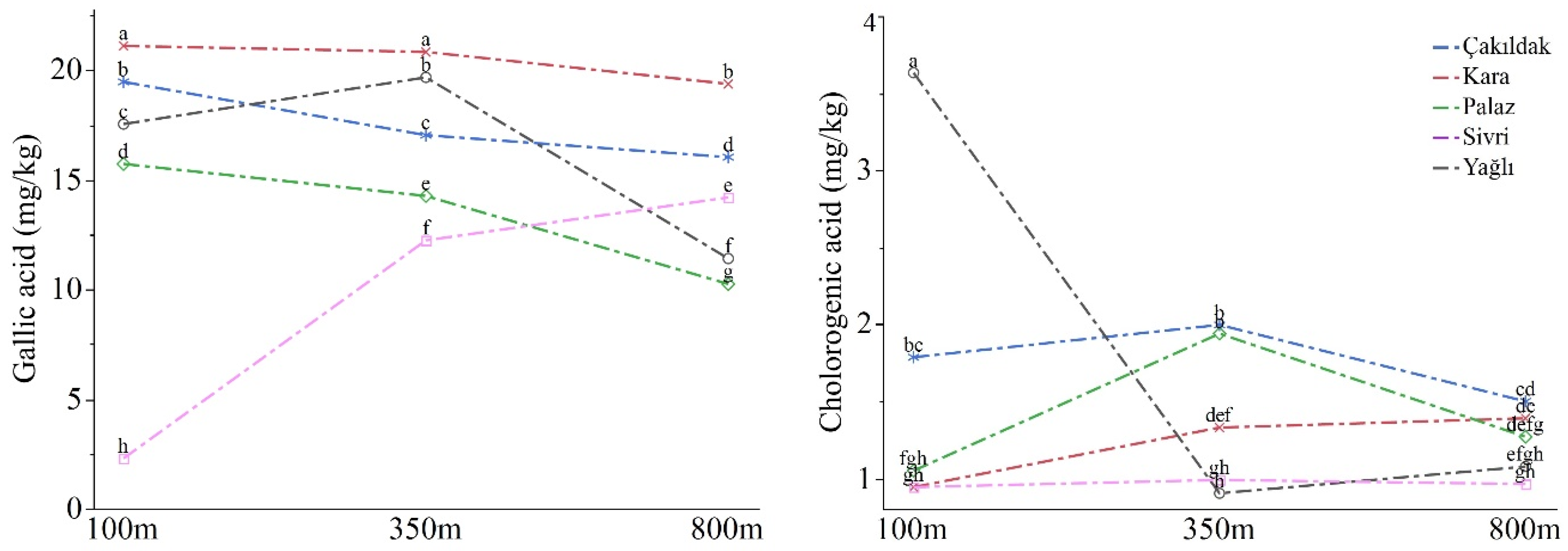
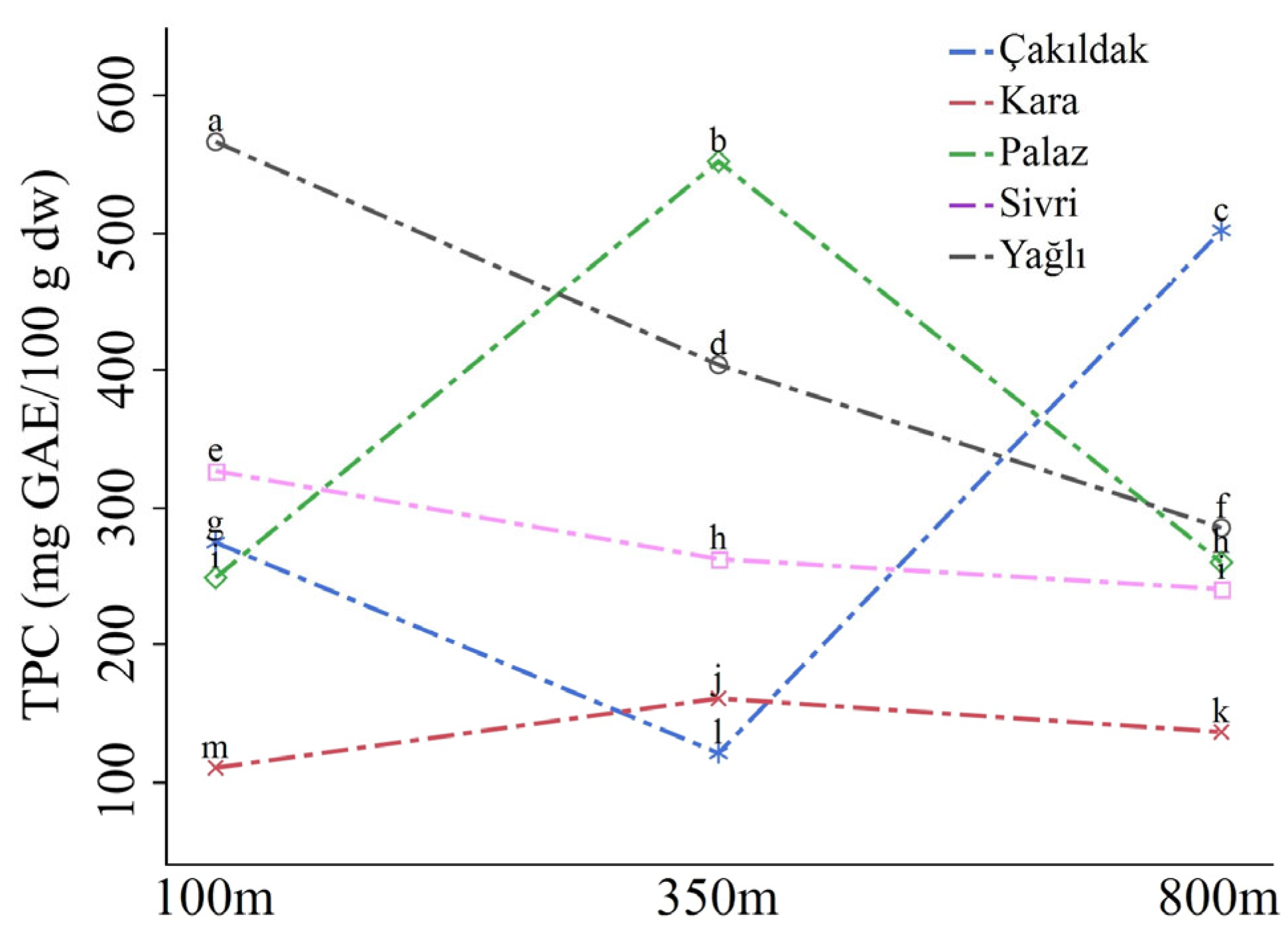
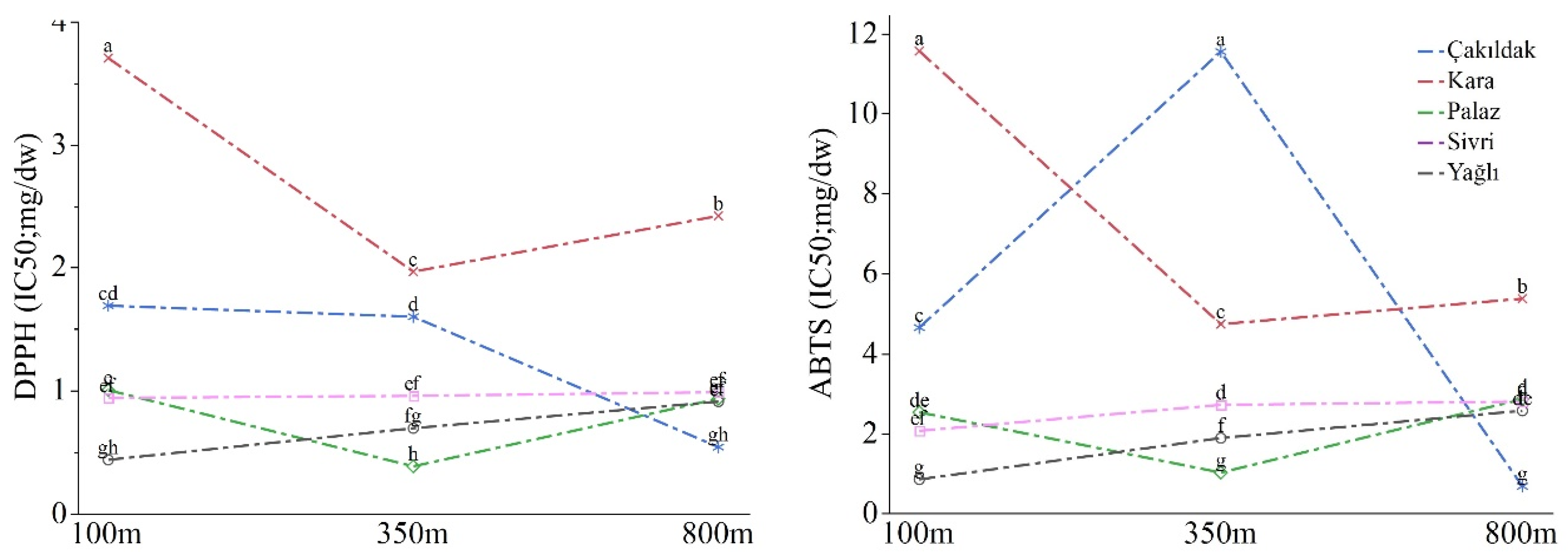
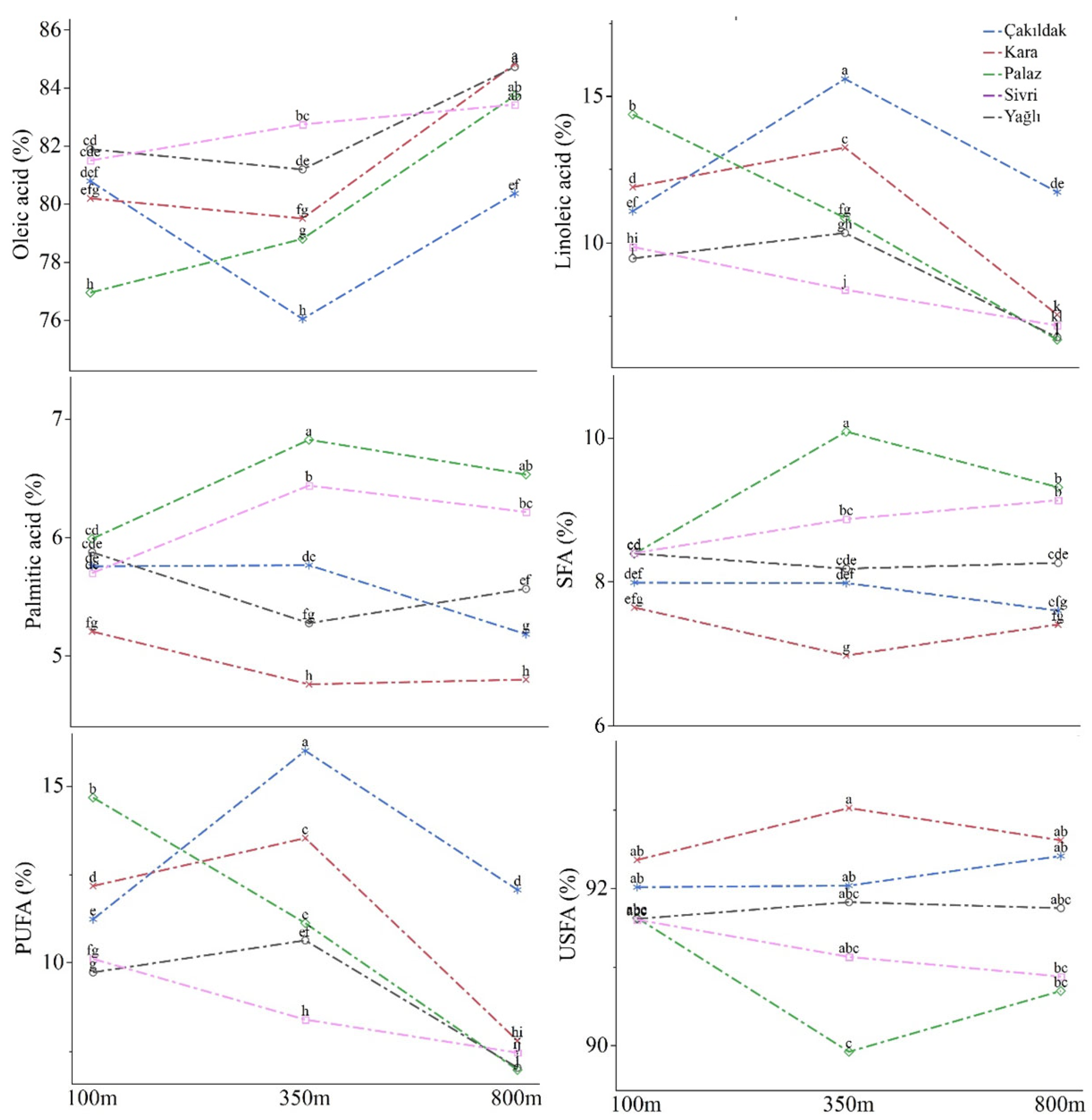
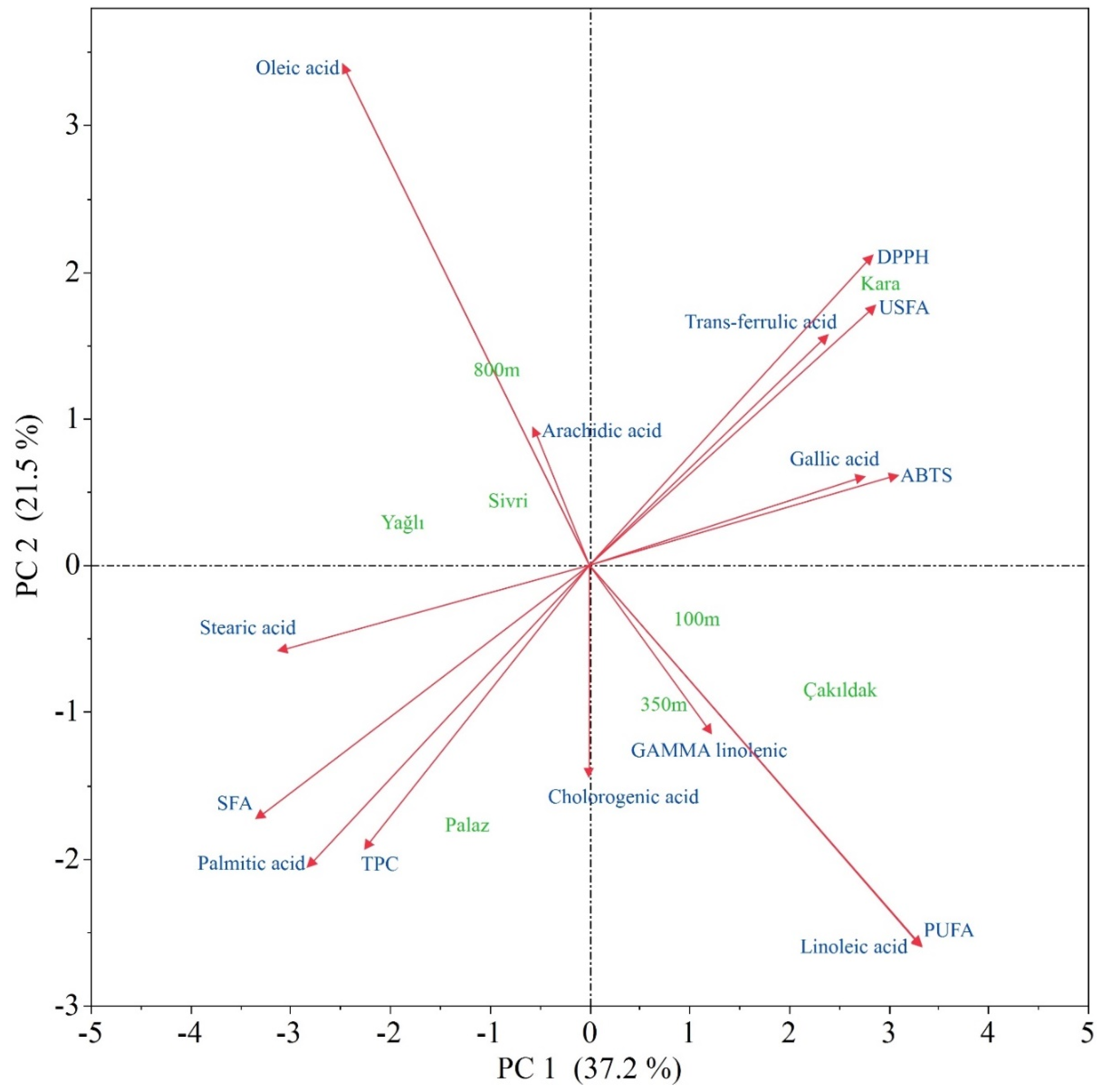
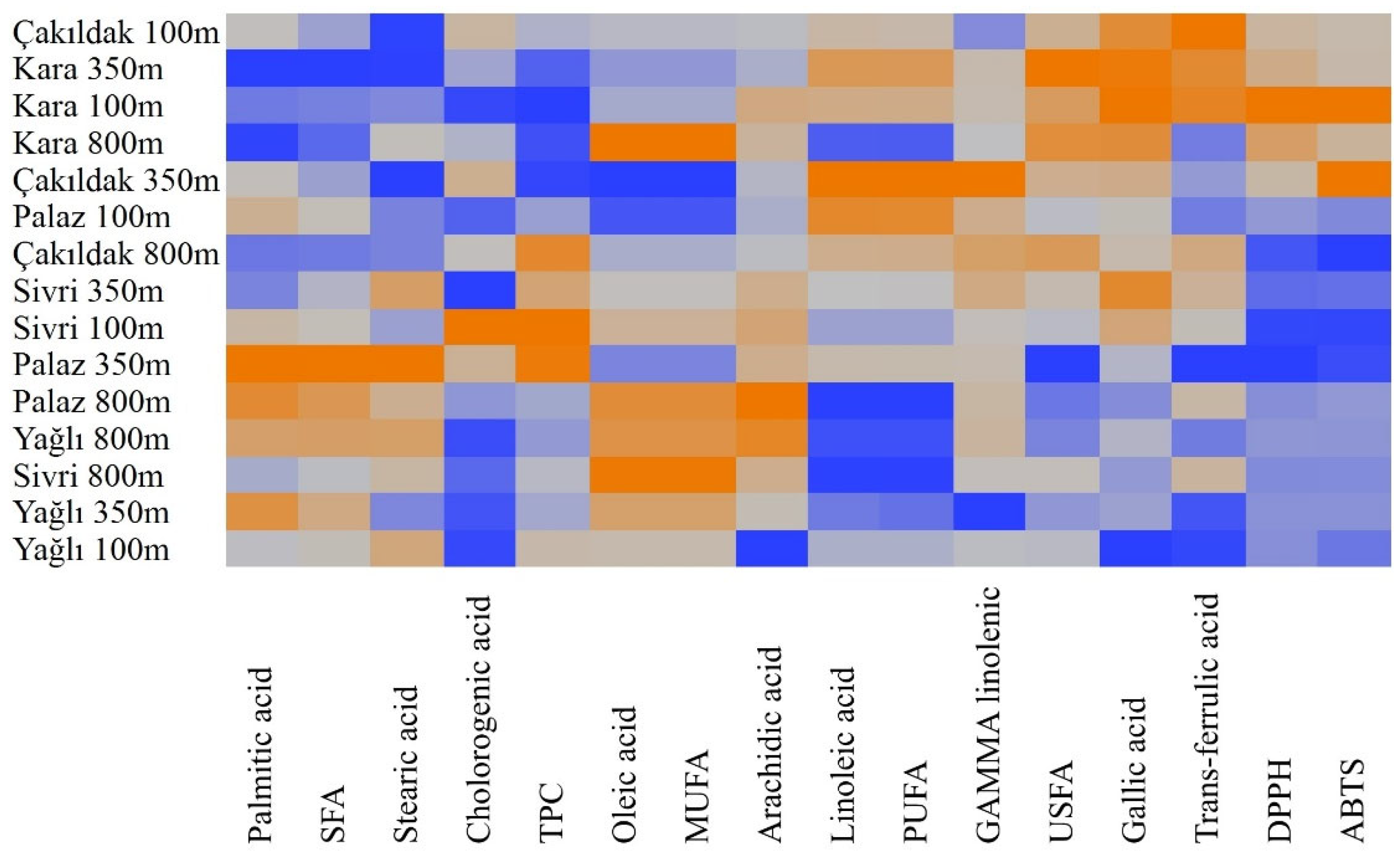
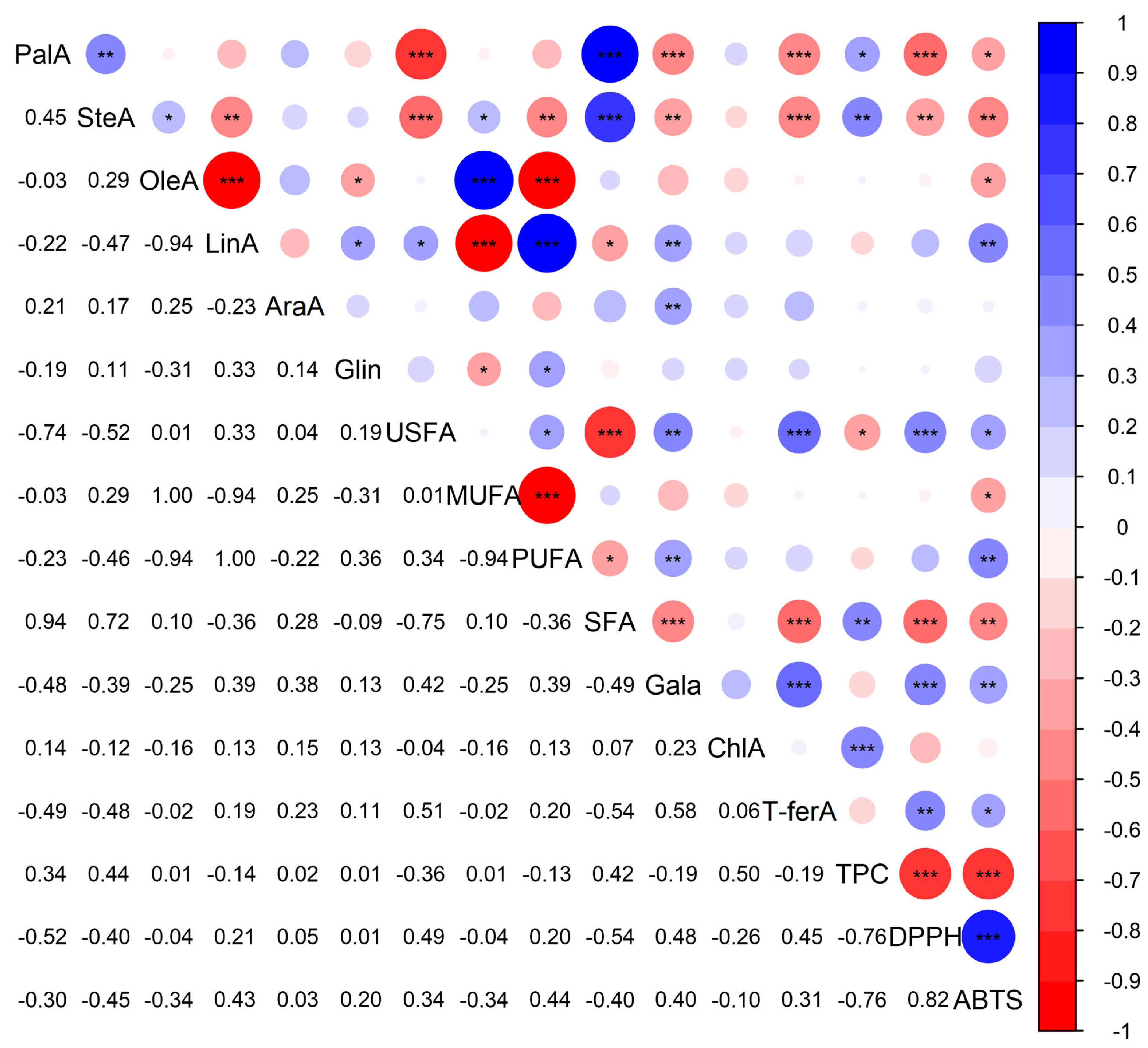
Disclaimer/Publisher’s Note: The statements, opinions and data contained in all publications are solely those of the individual author(s) and contributor(s) and not of MDPI and/or the editor(s). MDPI and/or the editor(s) disclaim responsibility for any injury to people or property resulting from any ideas, methods, instructions or products referred to in the content. |
© 2023 by the authors. Licensee MDPI, Basel, Switzerland. This article is an open access article distributed under the terms and conditions of the Creative Commons Attribution (CC BY) license (https://creativecommons.org/licenses/by/4.0/).
Share and Cite
Gülsoy, E.; Kaya, E.D.; Türkhan, A.; Bulut, M.; Koyuncu, M.; Güler, E.; Sayın, F.; Muradoğlu, F. The Effect of Altitude on Phenolic, Antioxidant and Fatty Acid Compositions of Some Turkish Hazelnut (Coryllus avellana L.) Cultivars. Molecules 2023, 28, 5067. https://doi.org/10.3390/molecules28135067
Gülsoy E, Kaya ED, Türkhan A, Bulut M, Koyuncu M, Güler E, Sayın F, Muradoğlu F. The Effect of Altitude on Phenolic, Antioxidant and Fatty Acid Compositions of Some Turkish Hazelnut (Coryllus avellana L.) Cultivars. Molecules. 2023; 28(13):5067. https://doi.org/10.3390/molecules28135067
Chicago/Turabian StyleGülsoy, Ersin, Elif Duygu Kaya, Ayşe Türkhan, Menekşe Bulut, Mubin Koyuncu, Emrah Güler, Figen Sayın, and Ferhad Muradoğlu. 2023. "The Effect of Altitude on Phenolic, Antioxidant and Fatty Acid Compositions of Some Turkish Hazelnut (Coryllus avellana L.) Cultivars" Molecules 28, no. 13: 5067. https://doi.org/10.3390/molecules28135067
APA StyleGülsoy, E., Kaya, E. D., Türkhan, A., Bulut, M., Koyuncu, M., Güler, E., Sayın, F., & Muradoğlu, F. (2023). The Effect of Altitude on Phenolic, Antioxidant and Fatty Acid Compositions of Some Turkish Hazelnut (Coryllus avellana L.) Cultivars. Molecules, 28(13), 5067. https://doi.org/10.3390/molecules28135067







